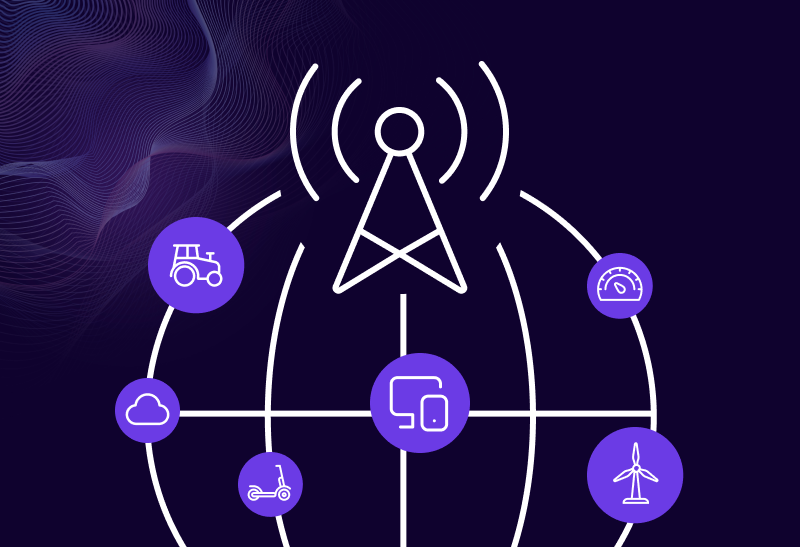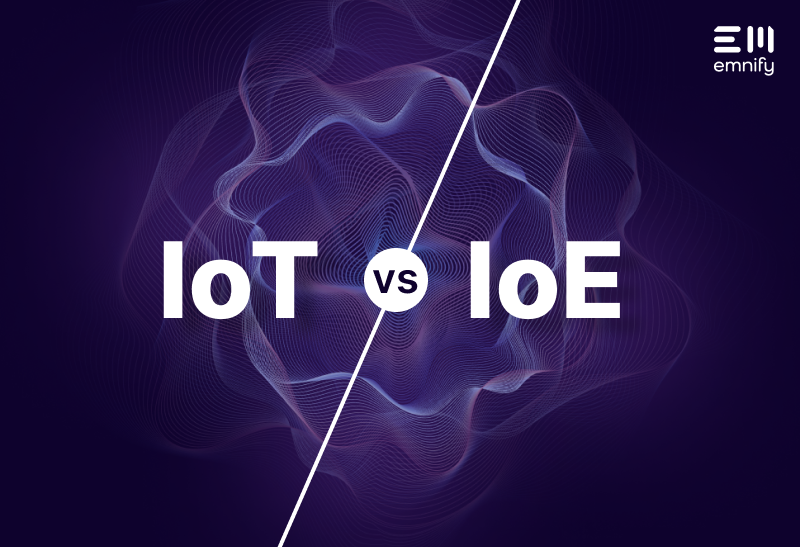

Cellular IoT uses cellular networks to connect physical devices to the Internet. The same cell towers that provide service to your smartphone can connect heavy machinery, security systems, hospital equipment, asset tracking systems, and billions of other devices to the internet. Cellular connectivity enables these devices to transmit and receive data, so end users can remotely monitor, analyze, and control them.
Cellular IoT is one of the most popular types of Internet of Things connectivity, primarily because it:
- Has excellent coverage
- Simplifies global deployment
- Works right out of the box
- Establishes secure connections
- Performs well in mobile, indoor, and outdoor applications
- Supports low and high bandwidth applications
While cellular networks were designed for phones, they’re highly versatile, and cellular technology has evolved to accommodate a wider range of devices and use cases over time. Like smartphones and other mobile devices, cellular IoT devices can use 2G, 3G, 4G, and 5G networks. But they don’t use data the same way as phones, and with billions of low-power devices relying on cellular technology, specialized cellular networks have also been developed specifically for IoT: LTE-M and NB-IoT.
For manufacturers building IoT devices, cellular IoT is one of the most reliable and accessible ways to enable connectivity. If you’re considering using cellular IoT, there’s more to unpack—and a lot of acronyms you’ll need to be familiar with.
In this guide, we’ll explore how cellular networks are used in IoT and the advantages cellular IoT offers.You should come away feeling equipped to talk about cellular IoT with colleagues, so you can decide if it’s right for your application. Let’s start by looking at what manufacturers tend to rely on cellular IoT for.
Advantages of cellular IoT
Cellular networks have several key factors that make them popular with IoT manufacturers. When it comes to convenience, coverage, and security, it’s hard for other IoT connectivity solutions to compete with cellular.
Global coverage
For large-scale global deployments, cellular M2M connectivity is generally considered the most reliable and beneficial connectivity method. You don’t need to build new infrastructure for every new deployment—you just have to connect to a network that’s already in place.
As you deploy in new countries, your cellular provider may have roaming agreements with another carrier that covers that region. If not, you can select a new carrier with local coverage. Using global IoT SIM cards, you don’t need to install new SIM cards, create new SKUs, or start new contracts to change your devices’ coverage. emnify’s SIM cards enable your devices to connect to more than 540 networks in over 180 countries with a single card.
Other solutions either make global connectivity more complicated or impossible. Cellular is a WAN (wide area network) with the long-range ability to connect globally using radio waves, which are sent and received via cell towers. In comparison, WiFi connectivity requires your device to remain much closer to the access point/router, preventing long-range mobility. Similarly, Bluetooth connectivity is also short range, requiring your device to be within 10–100 meters of the access point, depending on the power class.
Built-in authentication
Authentication can be a complex, data-intensive process. But it’s also critical that your devices only interact with authorized network entities, and that unauthorized devices can’t access your network. When you use cellular IoT, authentication is built-in by default.
Cellular networks use SIM cards to authenticate devices, associate them with a legitimate subscriber, and provide secure connectivity. Hackers can spoof IP addresses, but they can’t spoof a subscriber’s identity, which is stored on a SIM card.
Secure connectivity
When your device connects to a customer’s WiFi, it shares the connection with all the other devices on the WiFi network. If these devices have a security issue, it puts the others at risk—and the inverse is true, too. Connecting to a cellular network keeps your devices separate from your customers’ other Internet-connected devices. Manufacturers need to take IoT security seriously, and cellular connectivity gives you several security advantages, starting with the network your devices connect to.
IoT connectivity providers like emnify can also bolster the security offered by cellular networks with capabilities like VPN and IPSec, DNS filtering, IMEI lock, and more.
Types of networks cellular IoT uses
Over the years, cellular networks have grown exponentially faster and more powerful. But for IoT manufacturers, power and speed usually aren’t the main factors to consider. Later-generation cellular networks can come with greater power consumption and less coverage, too. The network you plan to use will impact your device’s range, coverage, frequency, power usage, modem size, cost, and longevity.
Generally speaking, the more advanced a network is, the more power connected devices will consume while in “idle mode,” but the less power they’ll consume to download or upload large amounts of data. More complex networks also tend to have more expensive modems. And that’s often not ideal for IoT.
Most people have at least heard the terms 2G, 3G, 4G, and 5G networks, but you may not know much about how they’re used in the Internet of Things. To accommodate the needs of most cellular IoT devices, cellular carriers have developed other network types specifically for large volumes of low-power devices: NB-IoT and LTE-M.
Here’s a quick explanation of each network type as it relates to IoT development.
2G networks: The most widely used network for cellular IoT
Most cellular IoT devices in the world today rely on the second generation of cellular networks, better known as 2G. 2G networks have worked well for logistics, telematics, and supply chain management applications because they allow devices to transmit basic alerts, status updates, and location data while using very low power.
Second-generation (2G) mobile networks have been around for about three decades. This is the scaffolding much of our cellular communication was built on. Using the GSM standard, 2G gave people the ability to send text messages, picture messages, and multimedia messages. IoT businesses like 2G connectivity because it’s simple and affordable to implement, and for now, it’s often widely available.
But 2G networks will soon be a thing of the past. Cellular carriers are beginning to shut off 2G networks to free up bandwidth for 4G and 5G networks. Some 2G networks have already gone offline, and many of the largest cellular carriers around the world are in the process of sunsetting theirs. As carriers continue to phase out their 2G networks, IoT devices that depend on them will become obsolete—unless they’re compatible with other networks.
3G networks: The go-to choice for consumer IoT devices
Like 2G, 3G has been used for things like logistics, telematics, and supply chain management. But thanks to the group of technologies known as UMTS, 3G can also facilitate more advanced processes like file sharing, streaming, analytics, and remote device management. This has made it ideal for consumer IoT devices and smart grids.
3G cellular networks are built on the capabilities of 2G technology, providing faster data transmission, and enabling mobile devices to connect directly to the internet. This came with a downside: 3G networks use 50 percent more power than 2G networks.
But 3G is on its way out the door, too. The transition isn’t as far along as the shift from 2G, but it will likely happen within the next few years. IoT applications built on 3G networks won’t last long, and many companies that rely on IoT devices are already aware that this change is underway—so they’re looking for devices that use 4G or low power wide area networks (LPWANs).
4G LTE networks: For more complex IoT solutions
4G LTE (long term evolution) is capable of data speeds more than 10 times faster than 3G, and it’s the world’s leading mobile network technology. 4G LTE technology enables devices to make low bandwidth voice calls (this is known as voice over long term evolution, or VoLTE), utilize video conferencing, and facilitate closed circuit television (CCTV).
Since 4G LTE allows devices to upload and download data at much faster speeds, it works well for IoT applications involving video transmission, such as security cameras. It’s also widely used in healthcare and car entertainment systems. In auto racing, teams use 4G connectivity to transmit immense amounts of data from race cars to engineers.
4G LTE connectivity uses more power than most IoT processes need (50 percent more than 3G connectivity), but a range of power-saving features can make it a viable option. And with carriers around the world repurposing bandwidth and infrastructure to increase coverage, 4G could be the dominant cellular network for years to come.
5G networks: The future of IoT
5G is the future of IoT. But it isn’t really how we use IoT in the present. While cellular carriers are rolling them out worldwide, 5G networks don’t have very widespread coverage yet. Even by 2025, they’re only projected to represent about 15 percent of total mobile connections worldwide.
This technology has a lot of potential for IoT, particularly for mobile, data-intensive applications where speed is crucial—like self-driving cars and emergency services. 5G networks can offer nearly real-time data transmission, and they can maintain a stable connection with devices moving at very high speeds. And while more advanced networks have typically demanded more power, 5G networks can support cellular connectivity with low power consumption.
At the moment, very few modems can facilitate 5G connectivity, and they are far more expensive than other options. So, for the time being, it isn’t a viable option for most IoT applications.
But as carriers phase out their 2G and 3G networks, that doesn’t mean IoT manufacturers are stuck choosing between too much power consumption and too little coverage. Cellular connectivity has evolved new solutions to accommodate the needs of most IoT applications.
Low power wide area networks (LPWAN)
Traditional cellular networks weren’t designed to support the massive influx of new devices that would need to share bandwidth. Their primary purpose was voice communication, and they were optimized for creating spontaneous connections. They’re always checking for incoming calls, actively listening to radio signals, and sending periodic tracking area updates (TAUs) to let the network know where they are. This is why traditionally connected devices consume so much power even when not in use—and it’s why extending battery life has been such a struggle for smartphones.
Most IoT devices don’t use cellular networks that way, and these unnecessary updates consume too much power.
For the vast majority of IoT applications, manufacturers want to maximize coverage while reducing power consumption and costs. In recent years, cellular providers have deployed new low-power wide area networks (LPWANs) to meet the specialized needs of IoT applications. LPWANs allow IoT devices to transmit or receive updates at fixed intervals or in response to an external trigger (such as a sensor), rather than maintaining a continuous connection. This drastically decreases power consumption.
There are two main types of LPWANs IoT manufacturers should be familiar with for cellular connectivity: NB-IoT and LTE-M.
Narrowband-IoT (NB-IoT): Finding bandwidth for IoT
Narrowband-IoT takes advantage of gaps in the radio frequency spectrum to provide more efficient connectivity and prevent interference. These unused frequency bands are known as “guard bands.” While cellular networks like 4G LTE use broadband connections (which support a wide range of radio frequencies), narrowband connections isolate devices to “narrower” ranges.
Narrowband-IoT introduces two major power-saving features: power saving mode (PSM) and discontinuous reception (DRX). PSM essentially puts the device to sleep when not in use, and DRX can extend the period that the device isn’t “actively listening” for a signal. As a result, devices that rely on NB-IoT can have years of battery life. And since NB-IoT was designed for the Internet of Things, it works on all frequency bands. You don’t need different modems for different regions, so global connectivity is both simple and cost effective.
NB-IoT is ideal for indoor applications or environments with a large volume of connected devices. It’s typically used in asset tracking, smart city applications (like smart meters and traffic lights), and alarm systems, where intermittent data transmissions don’t require high download or upload speeds.
The main challenges with using NB-IoT today are its lack of widespread availability and limited roaming agreements between carriers. If your solution relies on NB-IoT, it can affect where you can deploy, and it may require you to juggle multiple contracts. However, providers like emnify are helping businesses navigate this by combining coverage from multiple carriers.
Long term evolution (LTE-M): High-speed, low-power IoT connectivity
LTE-M (short for long term evolution machine type communication) is an offshoot of LTE technology specifically designed for the Internet of Things. It lets IoT devices connect to 4G networks, giving them more bandwidth and mobility than NB-IoT, as well as access to voice over long term evolution (VoLTE)—a more advanced voice service. However, it comes at the cost of more idle power consumption and more expensive modems.
Despite the greater power usage, LTE-M can still leverage PSM and DRX to significantly extend a device’s battery life, enabling it to work well for many of the same applications as NB-IoT while also enabling more functionality.
When a device needs to transmit or receive a larger volume of data, LTE-M uses less power than NB-IoT because the higher bandwidth allows it to upload and download data significantly faster. This helps “future proof” IoT devices because firmware upgrades may introduce new functionality that requires greater data consumption.
Another advantage LTE-M has over NB-IoT: better global coverage. LTE-M is available in far more countries, making it a more viable solution for global deployments.
Note: If you hear someone talk about eMTC (enhanced machine-type communication), that’s part of LTE-M.
Here’s how NB-IoT and LTE-M stack up against the other main cellular IoT technologies.

Keep learning about cellular IoT
In the years to come, cellular IoT will continue expanding into new industries and use cases, adding billions more connected devices. Whether you use IoT devices or not, it’s worth understanding how this pivotal technology works. You can explore more cellular IoT concepts in our IoT glossary or dive into our guide to the future of connectivity.
Is cellular IoT right for your business?
For IoT manufacturers, cellular connectivity offers several huge advantages. If your devices require global coverage, mobility, low power connectivity, or high data throughput, cellular networks may be your path to the Internet of Things.
Talk to one of our cellular IoT experts today. We’ll help you explore your options and navigate your application’s unique connectivity needs.
Get in touch with our IoT experts
Discover how emnify can help you grow your business and talk to one of our IoT consultants today!
David Garcia brings his passion and over 8 years experience in IoT/IIoT to Product Marketing, along with Extensive experience in Utilities, Energy, Transportation, Manufacturing vertical markets.


